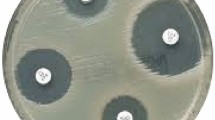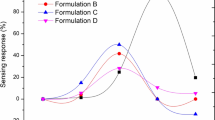Abstract
Antimicrobial nanocomposite films based on fish protein isolate (FPI)/fish skin gelatin (FSG) (1/1 w/w) prepared at pH 3 and 11 containing zinc oxide nanoparticles (ZnONP) at different levels (0–4 % w/w of protein) were characterised. At both pH 3 and pH 11, tensile strength (TS) increased, whilst elongation at break (EAB) and water vapour permeability (WVP) decreased as ZnONP content increased (p < 0.05). FPI/FSG-ZnO nanocomposite films had lower transparency, b*-values (yellowness), and ∆E*-values (total colour difference) than the control FPI/FSG film (p < 0.05). Attenuated total reflectance-Fourier transform infrared (ATR-FTIR) spectroscopic analysis revealed that there was interaction between ZnONP and protein in the film matrix. Based on thermogravimetric analysis, ZnONP could improve the thermal stability of the nanocomposite films. X-ray diffraction (XRD) analysis confirmed the crystalline structure of the ZnONP in the nanocomposite films. FPI/FSG-ZnO nanocomposite films, especially those prepared at pH 3, exhibited strong antibacterial activity and thus could be used as an active food packaging material.



Similar content being viewed by others
References
Alebooyeh, R., Nafchi, A. M., & Jokar, M. (2012). The effects of ZnO nanorods on the characteristics of sago starch biodegradable films. Journal of Chemical Health Risks, 2, 13–16.
AOAC. (2000). Official methods of analysis. Washington, DC: Association of Official Analysis Chemists.
Arfat, Y. A., & Benjakul, S. (2013). Gel strengthening effect of zinc salts in surimi from yellow stripe trevally. Food Bioscience, 3, 1–9.
Arfat, Y. A., Benjakul, S., Prodpran, T., & Osako, K. (2014). Development and characterisation of blend films based on fish protein isolate and fish skin gelatin. Food Hydrocolloids, 39, 58–67.
Bajpai, K. S., Chand, N., & Chaurasia, V. (2012). Nano zinc oxide-loaded calcium alginate films with potential antibacterial properties. Food and Bioprocess Technology, 5, 1871–1881.
Chen, H. (1995). Functional properties and applications of edible films made of milk proteins. Journal of Dairy Science, 78, 2563–2583.
Chinabhark, K., Benjakul, S., & Prodpran, T. (2007). Effect of pH on the properties of protein-based film from bigeye snapper (Priacanthus tayenus) surimi. Bioresource Technology, 98, 221–225.
Clinical and laboratory standards institute (2007). Performance standards for antimicrobial susceptibility testing; Seventeenth information supplement. CLSI document M100-S17 ISBN 1-56238-625-5). Clinical and Laboratory Standards Institute, 940 West Valley Road, Suite 1400, Wayne, Pennsylvania 19087–1898 USA.
Clinical and laboratory standards institute (2010). Methods for antimicrobial dilution and disk susceptibility testing of infrequently isolated or fastidious bacteria; Approved guideline—second edition. CLSI document M45-A2 ISBN 1-56238-732-4). Clinical and Laboratory Standards Institute, 940 West Valley Road, Suite 1400, Wayne, Pennsylvania 19087–1898 USA.
Espitia, P. J. P., et al. (2013). Physical–mechanical and antimicrobial properties of nanocomposite films with pediocin and ZnO nanoparticles. Carbohydrate Polymers, 94, 199–208.
Gennadios, A., Weller, C. L., Hanna, M. A., & Froning, G. W. (1996). Mechanical and barrier properties of egg albumin films. Journal of Food Science, 61, 585–589.
Han, J. H. (2000). Antimicrobial food packaging. Food Technology, 54, 56–65.
Han, J. H., & Floros, J. D. (1997). Casting antimicrobial packaging films and measuring their physical properties and antimicrobial activity. Journal of Plastic Film and Sheeting, 13, 287–298.
Hoque, M. S., Benjakul, S., Prodpran, T., & Songtipya, P. (2011). Properties of blend film based on cuttlefish (Sepia pharaonis) skin gelatin and mungbean protein isolate. International Journal of Biological Macromolecules, 49, 663–673.
Iwata, K., Ishizaki, S., Handa, A., & Tanaka, M. (2000). Preparation and characterization of edible films from fish water-soluble proteins. Fisheries Science, 66, 372–378.
Jongjareonrak, A., Rawdkuen, S., Chaijan, M., Benjakul, S., Osako, K., & Tanaka, M. (2010). Chemical compositions and characterization of skin gelatin from farmed giant catfish (Pangasianodon gigas). LWT-Food Science and Technology, 43, 161–165.
Kanmani, P., & Rhim, J. W. (2014). Physical, mechanical and antimicrobial properties of gelatin based active nanocomposite films containing AgNPs and nanoclay. Food Hydrocolloids, 35, 644–652.
Kovacevic, V., Vrsaljko, D., Lucic’Blagojevic, S., & Leskovac, M. (2008). Adhesion parameters at the interface in nanoparticulate filled polymer systems. Polymer Engineering & Science, 48, 1994–2002.
Ma, X. Y., & Zhang, W. D. (2009). Effects of flower-like ZnO nanowhiskers on the mechanical, thermal and antibacterial properties of waterborne polyurethane. Polymer Degradation and Stability, 94, 1103–1109.
Maria, T. M. C., Carvalho, R. A., Sobral, P. J. A., Habitante, A. M. B. Q., & Solorza-Feria, J. (2008). The effect of the degree of hydrolysis of the PVA and the plasticizer concentration on the color, opacity, and thermal and mechanical properties of films based on PVA and gelatin blends. Journal of Food Engineering, 87, 191–199.
McHugh, T. H., Aujard, J. F., & Krochta, J. M. (1994). Plasticized whey protein edible films: water vapor permeability properties. Journal of Food Science, 59, 416–423.
Muyonga, J. H., Cole, C. G. B., & Duodu, K. G. (2004). Characterisation of acid soluble collagen from skins of young and adult Nile perch (Lates niloticus). Food Chemistry, 85, 81–89.
Nikoo, M., Xu, X., Benjakul, S., Xu, G., Ramirez-Suarez, J. C., Ehsani, A., Kasankala, L. M., Duan, X., & Abbas, S. (2011). Characterization of gelatin from the skin of farmed Amur sturgeon (Acipenser schrenckii). International Aquatic Research, 3, 135–145.
Nuthong, P., Benjakul, S., & Prodpran, T. (2009). Characterization of porcine plasma protein-based films as affected by pretreatment and cross-linking agents. International Journal of Biological Macromolecules, 44, 143–148.
Prodpran, T., Benjakul, S., & Artharn, A. (2007). Properties and microstructure of protein-based film from round scad (Decapterus maruadsi) muscle as affected by palm oil and chitosan incorporation. International Journal of Biological Macromolecules, 41, 605–614.
Rouhi, J., Mahmud, S., Naderi, N., Ooi, C. H. R., & Mahmood, M. R. (2013). Physical properties of fish gelatin-based bio-nanocomposite films incorporated with ZnO nanorods. Nanoscale Research Letters, 8, 364–370.
Shi, L., Zhou, J., & Gunasekaran, S. (2008). Low temperature fabrication of ZnO-whey protein isolate nanocomposite. Materials Letters, 62, 4383–4285.
Shiku, Y., Hamaguchi, P. Y., Benjakul, S., Visessanguan, W., & Tanaka, M. (2004). Effect of surimi quality on properties of edible films based on Alaska pollack. Food Chemistry, 86, 493–499.
Sothornvit, R., Rhim, J.-W., & Hong, S.-I. (2009). Effect of nano-clay type on the physical and antimicrobial properties of whey protein isolate/clay composite films. Journal of Food Engineering, 91, 468–473.
Steel, R. G. D., & Torrie, J. H. (1980). Principle and procedure of statistics (2nd ed.). New York: McGraw-Hill.
Tam, K. H., Djurisic, A. B., Chan, C. M. N., Xi, Y. Y., Tse, C. W., Leung, Y. H., Chan, W. K., Leung, F. C. C., & Au, D. W. T. (2008). Antibacterial activity of ZnO nanorods prepared by a hydrothermal method. Thin Solid Films, 516, 6167–6174.
Tayel, A. A., El-Tras, W. F., Moussa, S., El-Baz, A. F., Mahrous, H., Salem, M. F., & Brimer, L. (2011). Antibacterial action of zinc oxide nanoparticles against foodborne pathogens. Journal of Food Safety, 31, 211–218.
Tongnuanchan, P., Benjakul, S., Prodpran, T., & Songtipya, P. (2011). Characteristics of film based on protein isolate from red tilapia muscle with negligible yellow discoloration. International Journal of Biological Macromolecules, 48, 758–767.
Yakimets, I., Wellner, N., Smith, A. C., Wilson, R. H., Farhat, I., & Mitchell, J. (2005). Mechanical properties with respect to water content of gelatin films in glassy state. Polymer, 46, 12577–12585.
Yehuala, G. A., & Emire, S. A. (2013). Antimicrobial activity, physicochemical and mechanical properties of Aloe (Aloe debrana) based packaging films. British Journal of Applied Science & Technology, 3, 1257–1275.
Yu, J., Yang, J., Liu, B., & Ma, X. (2009). Preparation and characterization of glycerol plasticized-pea starch/ZnO-carboxymethylcellulose sodium nanocomposites. Bioresource Technology, 100, 2832–2841.
Zhang, L., Jiang, Y., Ding, Y., Daskalakis, N., Jeuken, L., Povey, M., O’Neill, A., & York, D. (2010). Mechanistic investigation into antibacterial behaviour of suspensions of ZnO nanoparticles against E. coli. Journal of Nanoparticle Research, 12, 1625–1636.
Zhou, J. J., Wang, S. Y., & Gunasekaran, S. (2009). Preparation and characterization of whey protein film incorporated with TiO2 nanoparticles. Journal of Food Science, 74, N50–N56.
Acknowledgments
The authors would like to express their sincere thanks to Prince of Songkla University and National Research Council of Thailand for their financial support. The TRF Senior Research Scholar programme is gratefully acknowledged.
Author information
Authors and Affiliations
Corresponding author
Rights and permissions
About this article
Cite this article
Arfat, Y.A., Benjakul, S., Prodpran, T. et al. Physico-Mechanical Characterization and Antimicrobial Properties of Fish Protein Isolate/Fish Skin Gelatin-Zinc Oxide (ZnO) Nanocomposite Films. Food Bioprocess Technol 9, 101–112 (2016). https://doi.org/10.1007/s11947-015-1602-0
Received:
Accepted:
Published:
Issue Date:
DOI: https://doi.org/10.1007/s11947-015-1602-0




